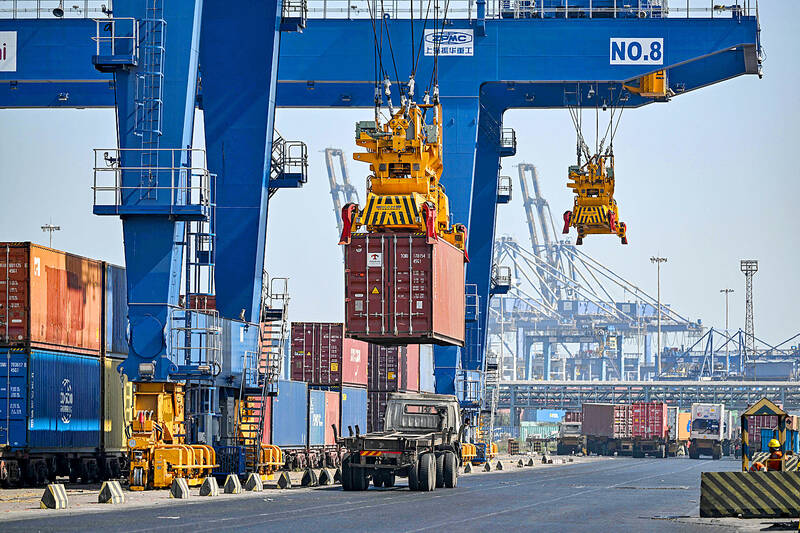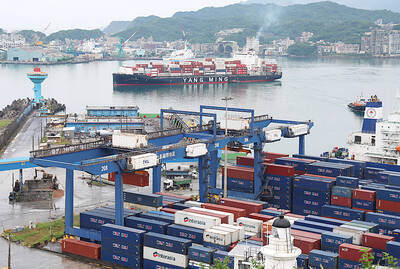India’s attempts at boosting its manufacturing sector by capitalizing on the US-China trade war have fallen short, with other Asian rivals benefiting to a much greater extent from escalating tensions between the world’s biggest economies, a study showed.
Between 2017 and last year, India’s total share in US imports rose by 0.6 percentage points to 2.7 percent while China’s portion dropped by about 8 percentage points to under 14 percent, Oxford Economics said.
The biggest beneficiary from the trade diversion in the region has been Vietnam, whose total share in US imports grew by 1.7 percentage points to 3.7 percent in the period.

Photo: AFP
Taiwan and South Korea have also made greater strides than India, increasing their share of US imports by 1 percentage point and 0.7 percentage points, respectively, according to Oxford.
The study underscores the uphill task facing Indian Prime Minister Narendra Modi as he attempts to boost the country’s lagging manufacturing sector, whose share of GDP has remained broadly stagnant at 17 percent for over a decade.
The research also implies that India might struggle to make significant gains if former US president Donald Trump returns as US president and follows through with a threat to impose a 60 percent tariff on Chinese goods.
“The US-China trade war so far has improved India’s export prospects only to a limited extent, dashing hopes that an escalation of the conflict could boost the lagging manufacturing sector,” Oxford Economics economist Alexandra Hermann wrote in a note. “India’s export strengths largely lie in sectors of the ‘old economy,’ where growth potential is limited and competition is fierce.”
India has made substantial advances in boosting electronic exports to the US, but its imports of components from China have surged as well, suggesting there is little value added to domestic manufacturing.
China accounted for about one-third of India’s imports of electronics, machinery, and chemicals and pharmaceuticals last year. For components such as certain semiconductor devices, as much as 67 percent of India’s imports came from China, Oxford said.

CHIP RACE: Three years of overbroad export controls drove foreign competitors to pursue their own AI chips, and ‘cost US taxpayers billions of dollars,’ Nvidia said China has figured out the US strategy for allowing it to buy Nvidia Corp’s H200s and is rejecting the artificial intelligence (AI) chip in favor of domestically developed semiconductors, White House AI adviser David Sacks said, citing news reports. US President Donald Trump on Monday said that he would allow shipments of Nvidia’s H200 chips to China, part of an administration effort backed by Sacks to challenge Chinese tech champions such as Huawei Technologies Co (華為) by bringing US competition to their home market. On Friday, Sacks signaled that he was uncertain about whether that approach would work. “They’re rejecting our chips,” Sacks

Taiwan’s exports soared 56 percent year-on-year to an all-time high of US$64.05 billion last month, propelled by surging global demand for artificial intelligence (AI), high-performance computing and cloud service infrastructure, the Ministry of Finance said yesterday. Department of Statistics Director-General Beatrice Tsai (蔡美娜) called the figure an unexpected upside surprise, citing a wave of technology orders from overseas customers alongside the usual year-end shopping season for technology products. Growth is likely to remain strong this month, she said, projecting a 40 percent to 45 percent expansion on an annual basis. The outperformance could prompt the Directorate-General of Budget, Accounting and

NATIONAL SECURITY: Intel’s testing of ACM tools despite US government control ‘highlights egregious gaps in US technology protection policies,’ a former official said Chipmaker Intel Corp has tested chipmaking tools this year from a toolmaker with deep roots in China and two overseas units that were targeted by US sanctions, according to two sources with direct knowledge of the matter. Intel, which fended off calls for its CEO’s resignation from US President Donald Trump in August over his alleged ties to China, got the tools from ACM Research Inc, a Fremont, California-based producer of chipmaking equipment. Two of ACM’s units, based in Shanghai and South Korea, were among a number of firms barred last year from receiving US technology over claims they have

BARRIERS: Gudeng’s chairman said it was unlikely that the US could replicate Taiwan’s science parks in Arizona, given its strict immigration policies and cultural differences Gudeng Precision Industrial Co (家登), which supplies wafer pods to the world’s major semiconductor firms, yesterday said it is in no rush to set up production in the US due to high costs. The company supplies its customers through a warehouse in Arizona jointly operated by TSS Holdings Ltd (德鑫控股), a joint holding of Gudeng and 17 Taiwanese firms in the semiconductor supply chain, including specialty plastic compounds producer Nytex Composites Co (耐特) and automated material handling system supplier Symtek Automation Asia Co (迅得). While the company has long been exploring the feasibility of setting up production in the US to address